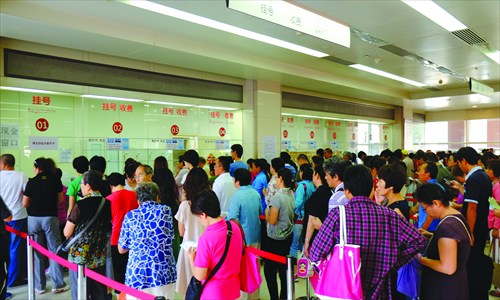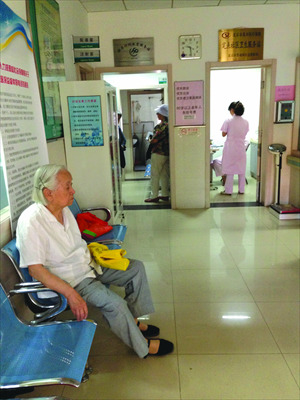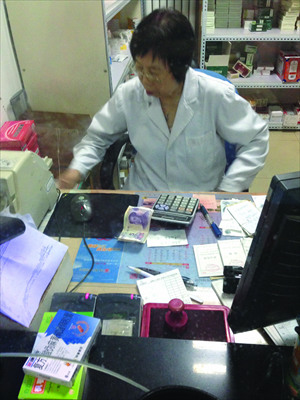

A long line of patients at Beijing Chaoyang Hospital. Photo: Yin Lu/GT


Scenes from a local clinic, which is much less crowded than the nearby Beijing Chaoyang Hospital. Photos:Yin Lu/GT
It was 9 am on Monday, and Beijing Chaoyang Hospital was crowded and filled with people in pain anxiously lining up and waiting in front of the registration windows, the pharmacy and the doctors' offices.
In contrast, at a small community clinic nestled inside a hutong a five minute walk away from the hospital, there were only four patients. All four were senior citizens having their blood pressure checked and listening to healthcare tips from doctors.
In Beijing, big hospitals are overcrowded and community clinics are neglected. Statistics released by the Beijing Public Health Information Center show that in 2012, the well-funded, highly specialized tertiary hospitals treated 81 million patients, while community health service centers had only half of the workload, 41 million patients.
"It should have been the other way around," said Cui Xiaobo, professor at Capital Medical University.
Choosing between big and small
In 2012, there were four practicing doctors for every 1,000 residents on average, according to the Beijing Health Bureau. "That is already a comparatively high rate internationally, but people still feel we're short of medical resources," said Cui, noting that the reason is "everybody is flooding to the tertiary A hospitals."
In China, hospitals are designated as primary, secondary and tertiary institutions according to their functions, facilities, and abilities to conduct medical research. Under each category they are designated as A, B, or C, with A being the top rating, according to hospital classification criteria by the National Health and Family Planning Commission.
While primary institutions only provide basic health care to a certain community, a tertiary hospital shoulders the responsibility of specialist health services for multiple regions, medical education and scientific research. "Each doctor has to see 60 to 80 patients every day, which is not the case in many other countries," Cui said.
"It's a waste that most of the patients big hospitals treated could have totally been cured by community clinics," Cui said. According to research conducted in the UK, among a community of 1,000 people, 500 would have health problems in one month, half of whom need to see a doctor. Most of the patients can be treated by community clinics, and only 15 of them need medical care from a big hospital. "That means general hospitals only serve for 1.5 percent of the population," Cui concluded.
However, many citizens have their own standards when it comes to deciding whether they should take a long trip to the big hospitals or just go to the clinic around the corner.
Shortcuts to health
A 50-year-old Beijing resident surnamed Wang got up at 6:30 am and came to Chaoyang hospital to get treatment for his fever and headaches. When asked why he did not just go to the community clinic instead to save a long wait, he answered that the big hospital was "more reassuring," noting, "The community clinic might not be able to treat it."
Zhou Mao, 27, had an infection in his ears after swimming, and went to a tertiary A hospital, the China-Japan Friendship Hospital. He went early in the morning but still failed to get a spot to see a doctor since there were too many people in line. Zhou called to make an appointment. The appointment was three days later, and the doctor only spent one minute with him before prescribing a laboratory test.
When Zhou finally came back from lining up to pay for the test, getting tested and getting the results, the doctor had already got off work. "Well, it meant starting all over again, from the registration," said Zhou.
Then he was reminded that there is a community clinic in the Shaoyaoju community where he has lived for five years. "There were only two or three patients that whole morning and the service was very nice. The doctor took a long time to do a test, explain the test results, help me understand my condition, tell me how to take the medicine, and give a few tips," said Zhou.
After that experience, Zhou and his family decided that they would only go to the big hospitals for something more serious than a cold, and that after a diagnosis they would get medicine and treatment in clinics. Zhou noticed that most of the patients in his community clinic were elder citizens, but some young people come too.
"But still, many of my friends bring their children to tertiary hospitals even for a mild fever or a cough," Zhou said.
Copyright ©1999-2018
Chinanews.com. All rights reserved.
Reproduction in whole or in part without permission is prohibited.